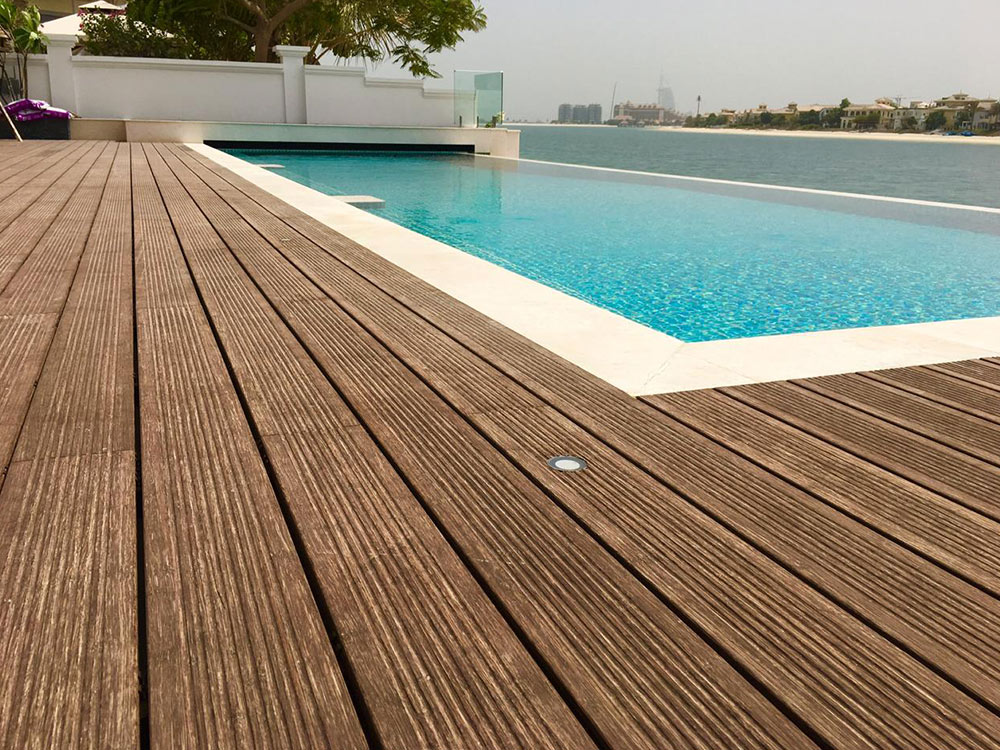
Choosing a patio material is probably the most important decision you will make when building a patio. Different circumstances call for different types of decking, such as composite decking and wood decking. Each option has its own unique aesthetic, maintenance requirements, and other important considerations to keep in mind when choosing. Deciding which patio material option is right for you depend on personal and practical taste.
Types of decking materials
There are many types of deck materials to choose from, including wood and composite woods. Before choosing a type of decking material, it’s important to research your options and understand the pros and cons of each, as well as the level of maintenance needed to keep your deck beautiful for a long time. Here are some of the most popular decking material options to choose from when building a deck, and factors that can help narrow down your decision.Let’s discuss the following deck materials:
Composite decking
Many composite shades resemble wood and are scratch-resistant, but performance varies by manufacturer and price.
Composite decking flooring is also very low-maintenance and does not require sanding or repainting. Washing the deck several times a year usually represents the extent of maintenance required. With minimal care, high-quality materials like Trex Composite Decking can last 25 years.
Composite decking is the best floor material for several reasons. First, it does not require painting or staining like wood. It is resistant to rot, insect damage, and weathering, meaning it will last longer and require less maintenance over time.
Composite paneling with cover: Composite decking with cover is a type of composite decking covered with strong and durable plastic. This plastic material helps protect composite decking from moisture and other elements, making it more resistant to rot, warping, and insect damage.
Covered patio building materials are also less prone to fading or staining than non-covered decking, making them the best option for patios based on durability. Installation is similar to traditional composites, but it is essential to follow the installation instructions of trusted manufacturers as accurate spacing is essential for proper ventilation.
Uncovered composite decking: Another type of composite decking is an uncovered deck. It lacks a plastic layer to protect the core, so it is not as durable as a covered deck.
Composite decking without covers is usually not recommended because it is more susceptible to damage from the elements and is likely to fade unevenly and stain over time. In addition, it is prone to mold, mildew, and fungus growth in humid climates and can be easily scratched and damaged.
Wooden decking
When planning your new patio, you can choose from several types of wooden patios. The most common decking woods include cedar, redwood, and pressure treated. Other wood deck options include tropical hardwoods such as pie, kumara, and tiger wood.
Pressure-treated wooden decking
Pressure-treated is one of the most common types of wood decking. While regular lumber is not treated with chemicals, pressure-treated lumber is infused with chemicals that repel insects, prevent mold and mildew, and protect the wood from rotting, helping to increase its natural durability. It is also easy to find, cut, and work with, although precautions such as a mask should be taken when cutting or drilling to avoid inhaling chemicals. In addition, residues should not be burned to prevent the release of chemical fumes.
If you don’t like the look of pressure-treated lumber, a stain can help to make it more attractive. However, it is recommended to let the pressure-treated deck wood weather for a few months before staining and consider resending before applying.
When comparing composite and wood decking, regular lumber tends to split, warp, or crack and pressure-treated wood requires much more maintenance than composite decking. But with care, including heavy washing, sanding, and regular re-staining, you can extend the life of your pressure-treated deck.
 Make Your Child’s Visit to the Dentist’s Office Enjoyable
Make Your Child’s Visit to the Dentist’s Office Enjoyable  Mastering Online Masterclasses: Choosing the Right Online Violin Instructors
Mastering Online Masterclasses: Choosing the Right Online Violin Instructors  Empowering Healthcare Professionals: How WT Farley Oxygen Regulators Enhance Patient Care
Empowering Healthcare Professionals: How WT Farley Oxygen Regulators Enhance Patient Care  Elevate Your Collection: Unveiling the Beauty of Custom Wine Cellars in Ottawa
Elevate Your Collection: Unveiling the Beauty of Custom Wine Cellars in Ottawa  Enhancing Your Online Presence with Real Estate SEO Services
Enhancing Your Online Presence with Real Estate SEO Services  The Epitome of Luxury: Elevating Spaces with Imperial High-End Kitchen Cabinets
The Epitome of Luxury: Elevating Spaces with Imperial High-End Kitchen Cabinets  Pokémon go accounts- Exploring the reasons behind player demand
Pokémon go accounts- Exploring the reasons behind player demand  Pokemon go shortcut to greatness – Buy now
Pokemon go shortcut to greatness – Buy now  Online slot games for classic fruit machine lovers
Online slot games for classic fruit machine lovers 



